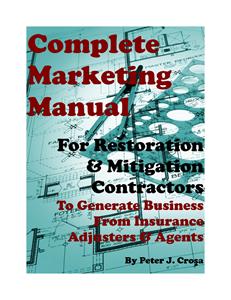Cross-Examination: Uncle Ed Pleads With You for Better Documentation
Break the Vicious Circle With Insurance Adjusters

Photo credit: Lisa L. Atkins.
Let’s face it; the property damage insurance claim environment has become increasingly adversarial in recent years. There is plenty of blame to go around. Some adjusters are too heavy-handed in adjusting and some restorers are too heavy-handed in billing. Insurers who routinely chop 25% off every restoration invoice as a matter of course cannot reasonably expect restorers not to invoice in a way that leaves them some room to bargain. The two sides intensify their efforts against one another, inexorably worsening the situation as the vicious circle grows, to the detriment of all involved, particularly the policyholder.
A “vicious cycle” is defined as “a sequence of reciprocal cause and effect in which two or more elements intensify and aggravate each other, leading inexorably to a worsening of the situation.”
Some restorers incorrectly presume that an insurer is bound to pay for work merely because the work was done and an invoice was sent. The insurance contract controls. Carriers are only required to pay the fair market value to correct damage resulting from a covered claim. Your customer can agree to pay a premium above that amount.
Fair market value is a range of prices that depends on the quality of the service rendered. By analogy, if one were to ask: “How much is a car worth in Dallas?” obviously, the answer depends on the type, age, performance and condition of the car, among other things. The point is that the value of cars in Dallas is not one number. It is a range of numbers.
The value of restoration services varies in the same way. The value of services rendered by unlicensed “Stan in a Van” on his very first water loss is less than the value of service promptly rendered by a high-performance company with certified, highly trained professional technicians using state-of-the-art equipment.
But how is the adjuster to know if you handled the job like Stan in a Van or a top-shelf company? The answer is documentation. If you’ve been to conferences or sat in on webinars, you’ve undoubtedly heard the mantra about the importance of documentation. The problem is that too many restorers don’t understand the mechanics of how to put together a good file that properly supports the invoice. They expect the adjuster to simply take their word for it. That is a bad strategy.

Understand that there are some restorers out there who inflate invoices or are unable to document the necessity of the work they perform. To add insult to injury, they attack adjusters who ask questions about the work and the invoice. This causes unnecessary harm to the reputation of this fine industry. Unfortunately, some adjusters overreact and view all restoration invoices with suspicion.

Just taking a million photos and dumping them in a folder is of limited value. Great, inexpensive project management software is available to help organize files into a photo album with meaningful captions and meta data. Take a couple of hours and learn how to use it. Document the loss like CSI would document a murder scene. Photographs taken by construction forensic experts commonly include dry-erase slates that show the property address, the name of the photographer, the date of the inspection and the name of the location where a photograph was taken. For a dollar, you can buy a red plastic arrow to point to small details, like hairline cracks, small spots of mold or other inconspicuous details. These help show the purpose of the photograph and give it meaning.
Document your files in a way that years later, a third party with no background on the loss and no access to the eyewitnesses can look at your file and reconstruct the key events of the project, and the pre-existing conditions.
Your file needs to tell a cohesive story, like a novel. Is there a real contract or just a “work authorization”? Did the customer approve the price or a schedule of values? Did the parties agree on a detailed scope of work? Is there a signed change order documenting the parties’ agreement on changes in the work? What areas of the property were impacted by the loss and how severely? What efforts were made to keep the customer in the loop? Don’t send estimates to adjusters behind your customers’ backs. Customers think that’s stinky.
The Institute of Inspection Cleaning and Restoration Certification (IICRC) water damage and mold standards contain lengthy lists of specific documents restorers “should” have in their files. Sadly, most restorers have never read those lists.
Among other things, the 2021 edition of the S500 Water Damage Standard states that the restorer “should” have:
- Records of the relevant details of the water intrusion
- Documents validating the drying process
- Detailed work or activity logs
- Documents and records verifying the use of equipment and materials; and
- Documentation of limitations, complexities and conflicts, and arrangements made to address them; and
- Much more!
Uncle Ed’s Simple Rule of Thumb for Documenting Files: “Show the Five W’s”
In case you can’t memorize every single item on the IICRC lists, my rule of thumb is that the file should clearly show “The Five W’s”: The Who, What, Where, When and Why of the job. In other words: “Who did what, where, when and why?”

Don’t presume your employees will be available to testify about your job three years from now. To collect top dollar, you may need to show that you would prevail if you went to court to collect. In court, you would have the burden of proving the existence of a binding contract, a commitment to pay, that work was performed and that the charges were reasonable under the circumstances. Assume that every invoice will be hotly contested and document your file accordingly.
The file should stand on its own. Document your files in a way that years later, a third party with no background on the loss and no access to the eyewitnesses can look at your file and reconstruct the key events of the project, and the pre-existing conditions. They should reveal compelling reasons why you should be paid what you charged, and how the work was done in a non-negligent manner.
So, please, don’t make Uncle Ed sad. Document your files properly so the claims handling dynamic will become less adversarial, you get paid faster and we all live happily ever after.
Sincerely,

Disclaimer: This article is intended for general information purposes and is not intended to be legal advice. Legal issues should be presented to qualified counsel licensed to practice law in the jurisdiction where the events occurred.
Looking for a reprint of this article?
From high-res PDFs to custom plaques, order your copy today!










